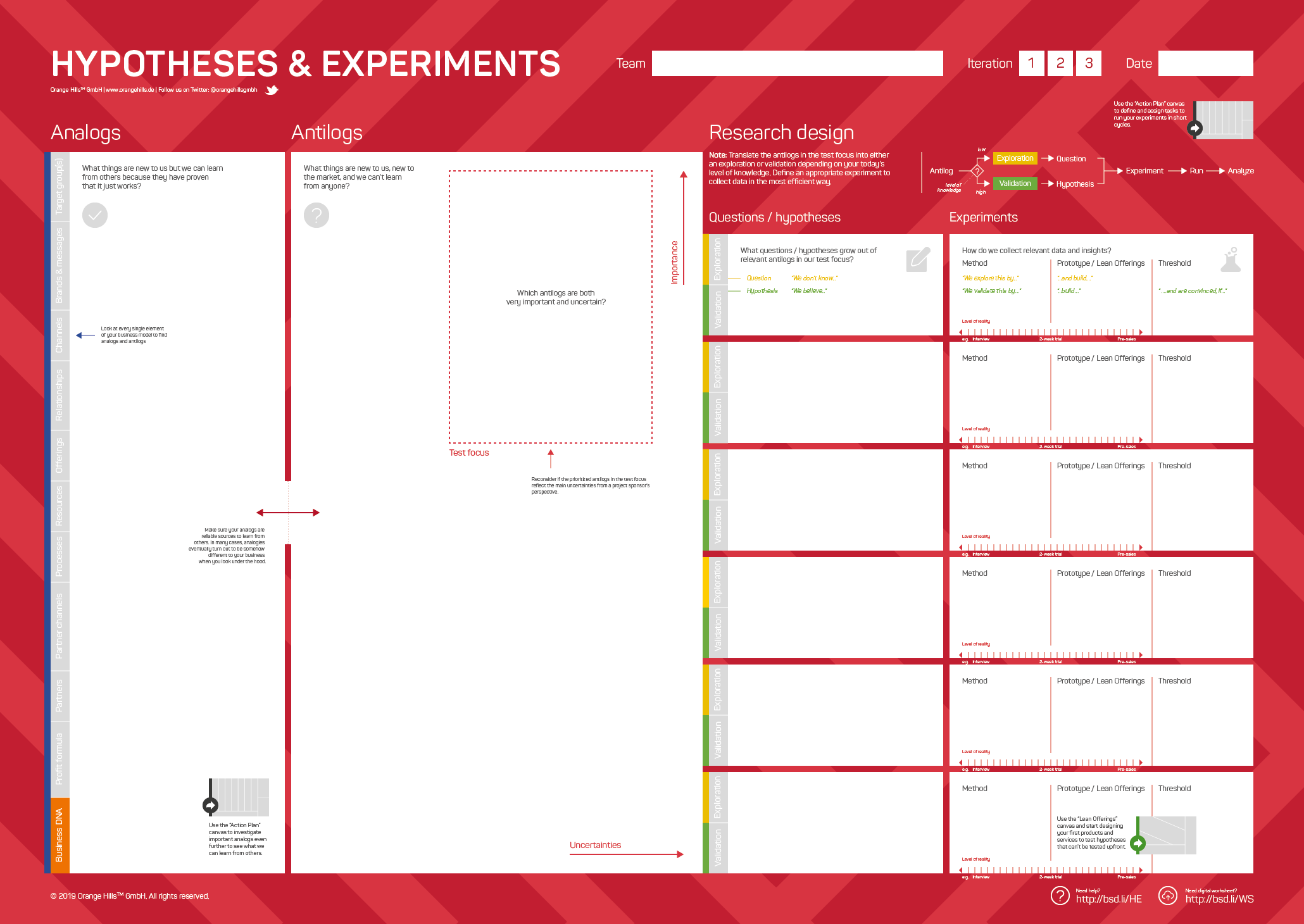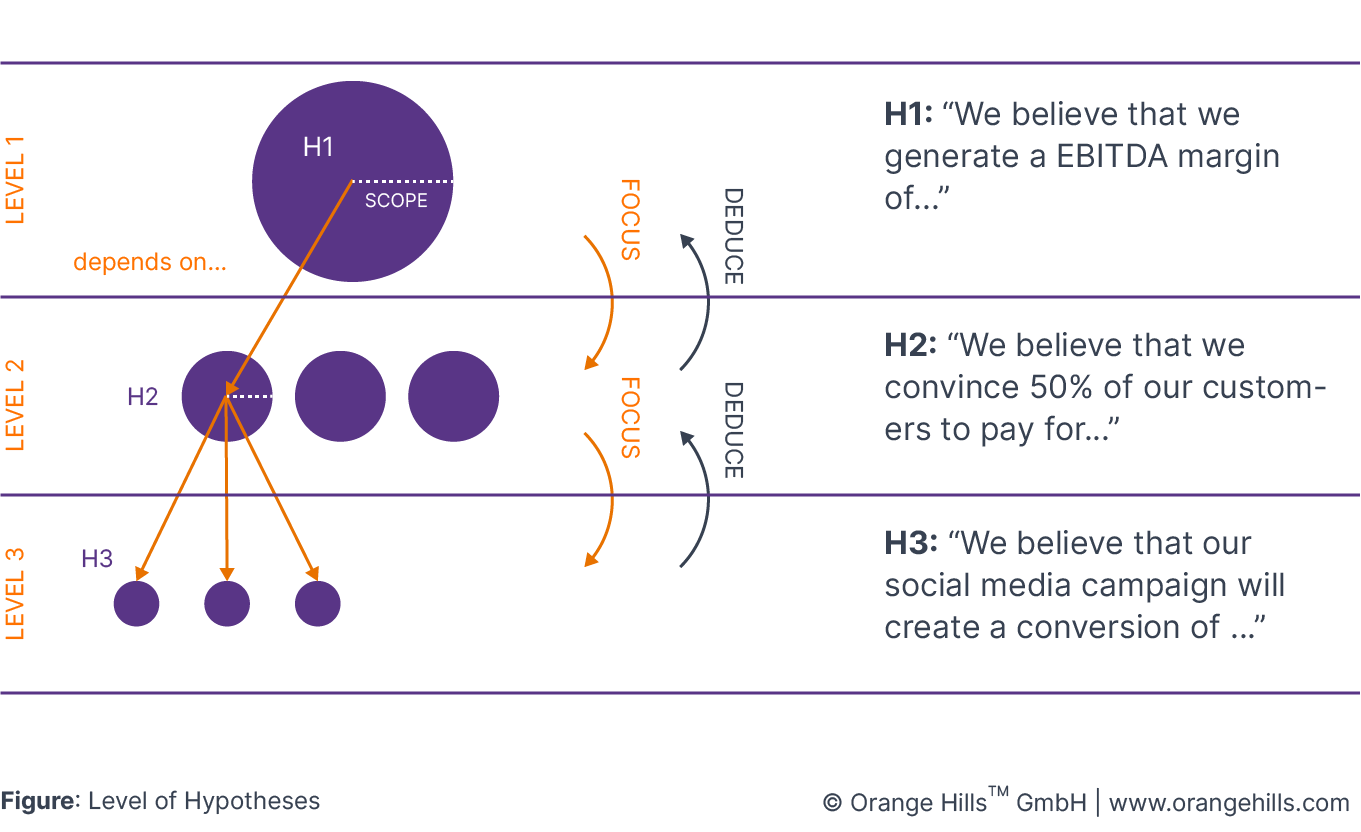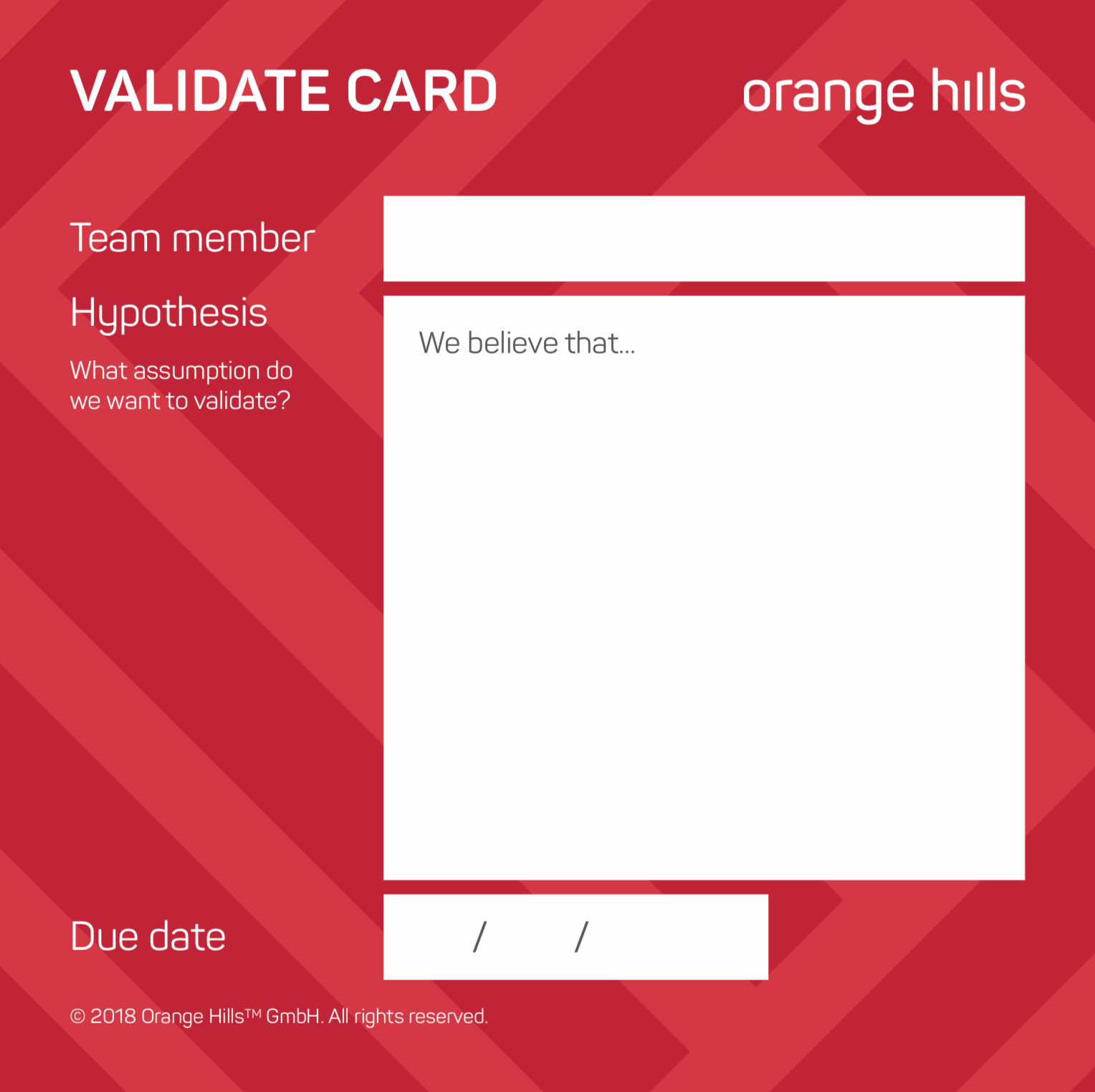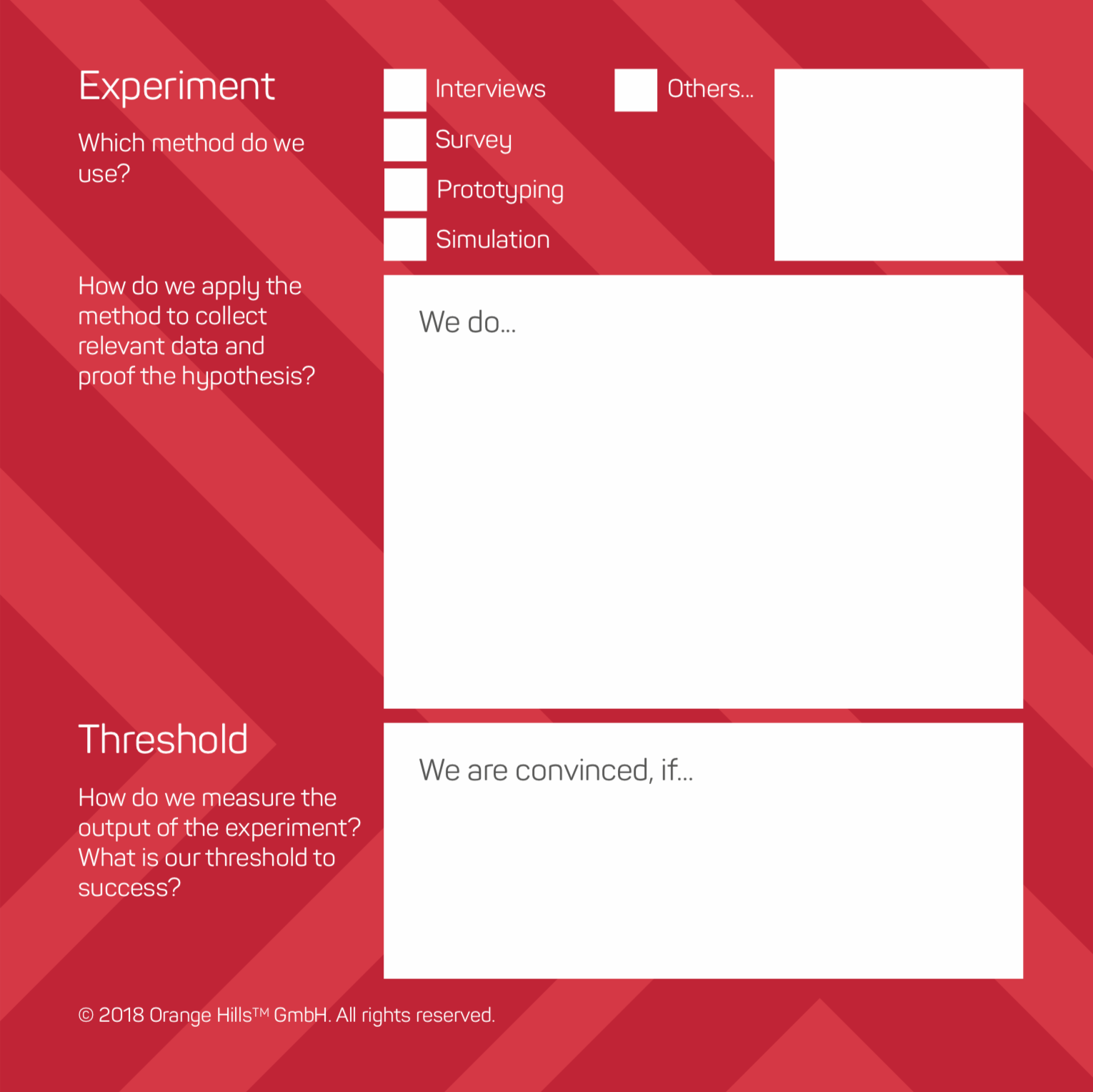Hypotheses & Experiments
The Hypotheses & Experiments template is the heart of Business Design and helps you to plan your Validate Phase. Learn more about key elements, go through further instructions and download the template for your team.
Content
1. Overview
The Hypotheses & Experiments template can help you reveal critical questions (= exploration) and hypotheses (= validation) inherent in your new business model, product, service or software, which are both uncertain and important for the success of the innovation endeavour. These questions and hypotheses often address “antilogs” around technical feasibility, economic viability or future customer behaviour. Moreover, this canvas provides space to plan how to explore or test the questions and hypotheses as efficiently as possible with experiments before or after launch. Do not test ideas! Test hypotheses that your ideas are based on!
Translate only the most important and uncertain antilogs (= test focus) into either a question or a testable hypothesis. This, however, is not an easy task, especially at the beginning of innovation projects. We usually start with explorative questions and high-level hypotheses that are hard to test. Over time, we are eventually able to nail them down to very specific but still relevant statements. Here is an example:
We believe that payment by credit cards will be accepted by the majority of our customers.
Every question or hypothesis needs an experiment in order to be explored or tested. An experiment defines a sequence of actions needed to collect data and measure the threshold: <action><measurement><timeframe>
We integrate credit card payments into our check-out process for X customers and count the usage within the next 3 weeks.
Many experiments require a Prototype (pre launch), whereas some experiments can only be conducted after launching Lean Offerings (post launch).
When validating a hypothesis, we define a threshold that determines when we are convinced that a hypothesis is "true" or "false".
We are convinced, if more than 50% of our customers who ordered products in the given timeframe used credit cards as payment method.
2. Layout & Download

3. Key Elements
Element | Question | Comments |
Analogs | What things are new to us but we can learn from others because they have proven that it just works? | Some analogs might turn out to be antilogs because we find out that the solutions of others are more different than we first thought or are not applicable to our business model, product, service or software. A good structure for an analog is: "We know from_that_ just works for us." |
Antilogs | What things are new to us, new to the market and we can`t learn from anyone? | Some antilogs may become analogs during a sprint due to a growing knowledge base. A good structure for an antilog is: "We don't know whether___works for us." |
Test focus | Which antilogs are both very important and uncertain? | These antilogs are crucial to our business model, product, service or software. They are the first to be explored or validated. |
Questions / hypotheses | What questions / hypotheses grow out of relevant antilogs in our test focus? | Questions will be explored while hypotheses will be validated. |
Experiments | How do we collect relevant data and insights (= facts) to better evaluate our business model, product, service or software? | Design experiments in a way that you would trust the results for better decision-making ("replace opinions with facts"). Have a look at our overview of different types of experiments. |
This tool is the heart of Business Design! Here is where the magic happens. Invest as much time in coming up with a good research design as you have invested in designing your actual product, software or business model. Think about your sponsor: The results of your experiments is THE source of wisdom for your sponsor to make decision on whether or not to further invest in the project. Don't fool yourself! Provide your sponsor the right support to make up his / her mind.

4. Usage Scenarios
Gathering and prioritizing uncertainties
Defining questions, hypotheses and experiments based on uncertainties
5. Instructions for Coaches
The Hypotheses & Experiments template is a good way to gather all kinds of uncertainties related to the business model.
The key is to identify as many uncertainties as possible and to then sort them by analogs or antilogs. Mark the uncertainties in your business model first.
It cannot be said that antilogs are more important than analogs. Analogs make life easier because one can simply copy from others. However, if only analogs and no antilogs were identified the sprint would stop because no further validation would be needed.
Keep the order to first gather uncertainties, to then sort them by analogs or antilogs and to then sort the antilogs by uncertainty and importance. This is one of the reasons why we use Post-its because we can move them around on the template.
Be really precise how questions or hypotheses are phrased. Beginning every Post-it with "We believe that..." or "We don't know..." is an additional help to reflect whether validation or exploration are the right method.
6. Q & A
What is the difference between "Exploration" and "Validation"? Exploration is a scientific approach of empirical research to gain first insights in a field that is quite new and not understood quite well. Your level of knowledge in this field is low. Explorative research methods help you shed light into the unknown and try to increase your understanding on how things work. Observations of customers, structured interviews, case studies or experimental prototypes are well-proven methods in that space. Validation requires a testable hypothesis that you want to validate (better "falsify"). To phrase a hypothesis, however, you already need deep knowledge in a certain field. Otherwise you will not be able to phrase a hypothesis that eventually can be validated. Surveys or other ways of collecting a vast amount of data with software systems, for instance, are good methods here.
I always formulate my hypotheses in a way that it is almost impossible to find an experiment to test them. What's wrong? Well, the chance is high that you either don't know enough about the subject and you better explore rather than validate the subject or you are not concrete enough in your thinking. Reduce your scope and boil down your hypotheses (H1) to something more focused (H2 or H3) and try to find a good experiment again. Have a look at the "Levels of Hypotheses" picture above.
7. Validate Cards
Validate Cards can be used to extract formulated hypotheses from the Hypotheses & Experiments template to plan corresponding experiments in detail and assign team members who are responsible for the execution. The experiment is defined by the method, how you apply it to collect relevant data and how you measure the output of the experiment. Furthermore, a threshold can be defined in terms of "We are convinced if...". This ensures to clarify in advance what result of the experiment is anticipated and how it will be rated. The assigned team member can take the card to do his / her "homework" until the defined due date. Don't forget to plan corresponding activities in the Action Plan.


